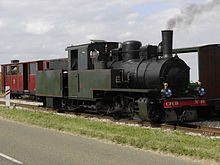Société Franco-Belge
The Société Franco-Belge de Matériel de Chemins de Fer was a French mechanical engineering company that mainly specialized in the construction of rail vehicles and their components and accessories. The company was based in Raismes near Valenciennes in the north department .
prehistory

In 1859, the Belgian entrepreneur Charles Evrard bought the company Parmentier Freres et Cie from La Croyère (near La Louvière ). He combined them with his Brussels- based Établissements Charles Évrard to form Compagnie Belge pour la Construction de Matériel de Chemins de Fer with a capital of 1 million francs. At the world exhibition in 1867, it showed a locomotive , passenger and freight cars as well as a rail steam crane .
From 1876 steam railcars were also produced, from 1880 under Rowan license , which was acquired together with Borsig . By 1891 the two companies had built around 85 three- and four-axle Rowan trams and branch lines . The first of these railcars was a double-decker car with four axles for 98 passengers, 8 of them in the first, 30 in the second and 60 in the third class in the open upper floor.
history
On September 15, 1881, the company was incorporated into the Société Anonyme pour la Construction de Machines et Matériel de Chemins de Fer , in which the Banque franco-Egyptienne was involved. The factory in Brussels was closed that year. In addition to La Croyère, a second plant was built in Raismes in northern France in 1882 in order to undermine French protectionism . At first only parts made in Belgium were assembled there.
Charles Evrard died in 1896. In 1911 the company was renamed Société Franco-Belge de Matérial de Chemins de Fer . The locomotives and railroad cars produced were sold not only to France and Belgium, but also to Asian , African and South American countries. Up to 1914 around 50 locomotives and more than 1,500 cars were built annually. Until then, Belgians had dominated the company's board of directors, but from then on the ownership structure changed in favor of the French. During the First World War , the factory in Reismes was supposed to carry out repair work for the German occupiers . Since this was refused, it was temporarily converted into a sawmill .
In 1927 the company became the Société Franco-Belge de Matériel de Chemins de Fer (headquartered in Raismes, France) and the Société Anglo-Franco-Belge de Matériel de Chemins de Fer (SAFB) (headquartered in La Croyère, Belgium) with English capital ) split.

In the 1930s, the Société Franco-Belge de Matériel de Chemins de Fer in Raismes built, among other things, Garratt locomotives for Algeria and cars for the train of the Ethiopian ruler Haile Selassie .
During the German occupation of France in World War II , German locomotives were repaired at the Raismes plant. Its director Gilbert Bostsarron joined the Resistance in 1941 . As a member of the "Cohors" resistance group in the North Department, he recruited agents for intelligence services and acts of sabotage in his work . He was arrested by the German occupiers on December 14, 1943 and executed on January 20, 1944.
In the early 1950s, more than 80 WG class freight locomotives were built for Indian Railways . In the 1970s, several hundred Corail cars were built in Raismes for the SNCF and 118 subway cars for the Metropolitan Atlanta Rapid Transit Authority in Atlanta , USA .
In 1982 the Société Franco-Belge de Matériel de Chemins de Fer was part of the Alsthom railway group (since 1998: Alstom). In its plant in Petite-Forêt near Raismes, underground trains, trams and double-decker cars are built.
Société Anglo-Franco-Belge (AFB)
The Belgian Société Anonyme Anglo-Franco-Belge des Ateliers de la Croyère, Seneffe et Godarville (AFB) was created in 1939 through the acquisition of two metalworking factories in Seneffe and Godarville by the SAFB. During the German occupation of Belgium in World War II , the company built more than 100 war steam locomotives (KDL) for the Deutsche Reichsbahn and carried out repairs on their behalf.
In 1954, the National Company of the Belgian Railways (NMBS / SNCB) ordered 40 diesel-electric mainline locomotives from AFB . The machines, which are largely identical to the NoHAB AA16 - even the control desk was arranged on the right-hand side despite the left-hand traffic - were created as series 202 (with steam boiler) for passenger trains and 203 (without boiler) for freight train services. The four last delivered locomotives of the 204 series had a modified transmission and a higher top speed. The third to sixth machines built were delivered to the Société Nationale des Chemins de Fer Luxembourgeois (CFL) in Luxembourg .
In 1964, the Société Anonyme des Ateliers Germain was bought and the company name changed to Société Anglo-Germain . A lack of orders and the announcement of a possible plant closure led to a strike that received national attention and even brought Prime Minister Paul Vanden Boeynants into the plant. In 1968 the Belgian offshoot of the former Société Franco-Belge filed for bankruptcy .
Web links
Individual evidence
- ↑ Firmin Lentacker: La frontière francobelge. Service de reproduction des thèses, Univ. de Lille, 1974 limited preview in Google Book search
- ^ Walter Hefti: Dampf-Strassenbahnen , Birkhäuser Verlag Basel (1984); ISBN 3-7643-1536-9 , hardcover; Pp. 37-40
- ^ Odette Hardy-Hémery: Industries, patronat et ouvriers du Valenciennois pendant le premier XXè siècle. Atelier National Reproduction des Theses, Université Lille III, 1985 limited preview in the Google book search
- ↑ rows 52/53/54 Belgian Ataatsbahnen in Railway Journal Special Issue 4/2003 ff NOHAB, S. 58th
Coordinates: 50 ° 23 ′ 10.1 " N , 3 ° 28 ′ 29.6" E


